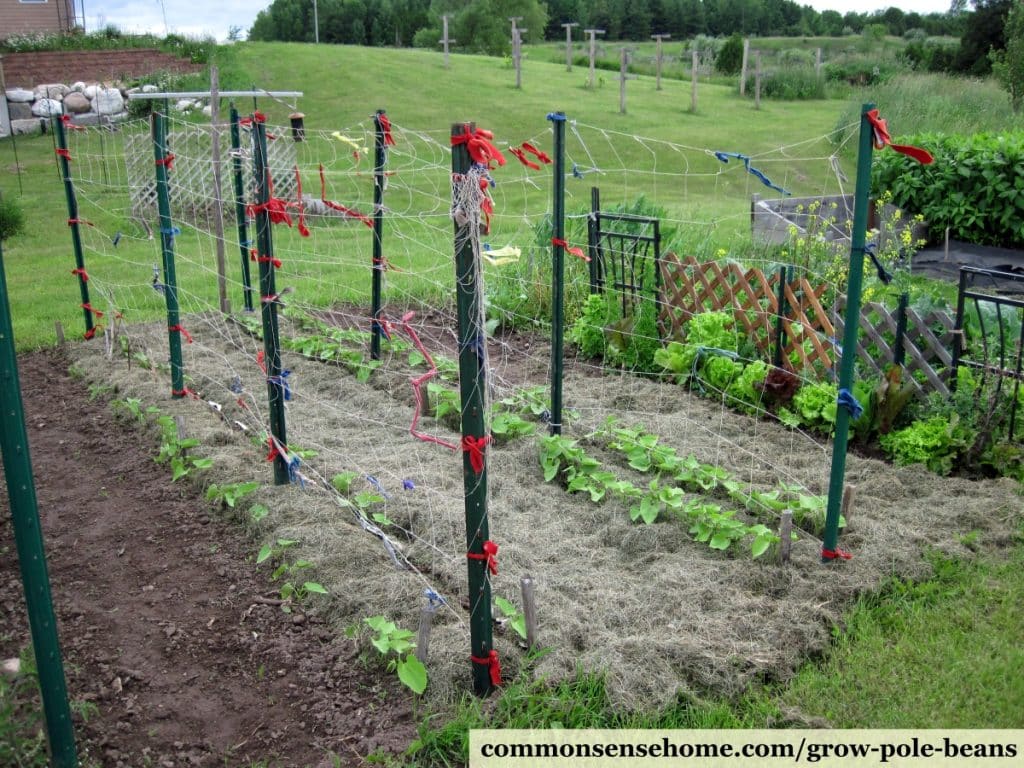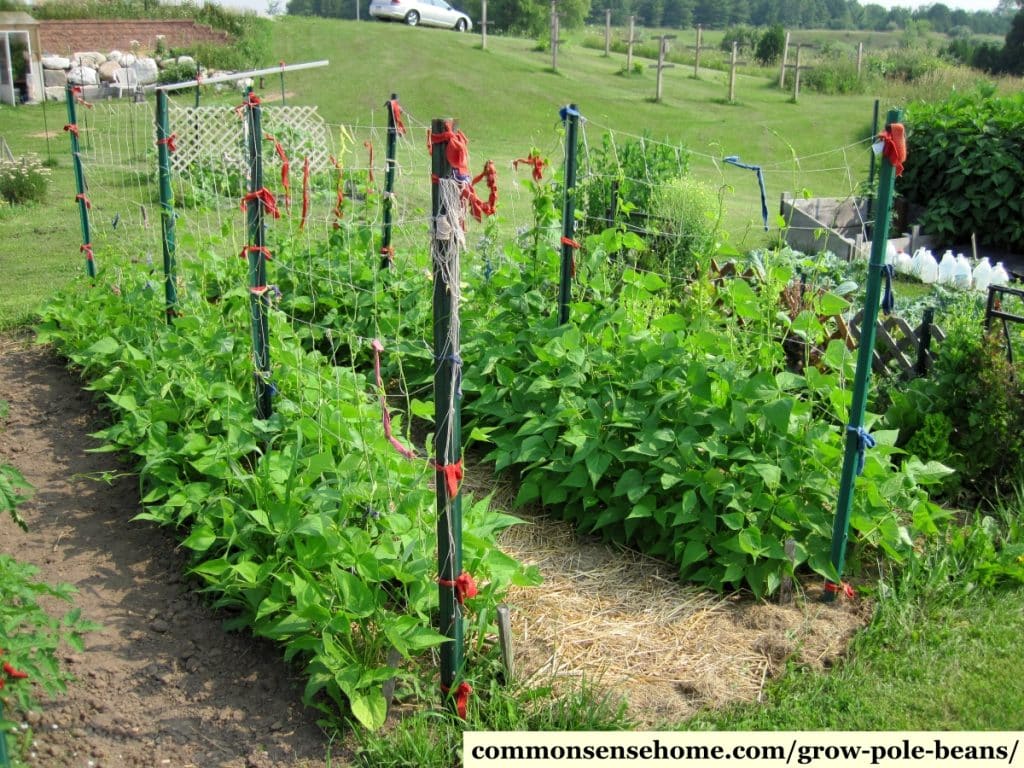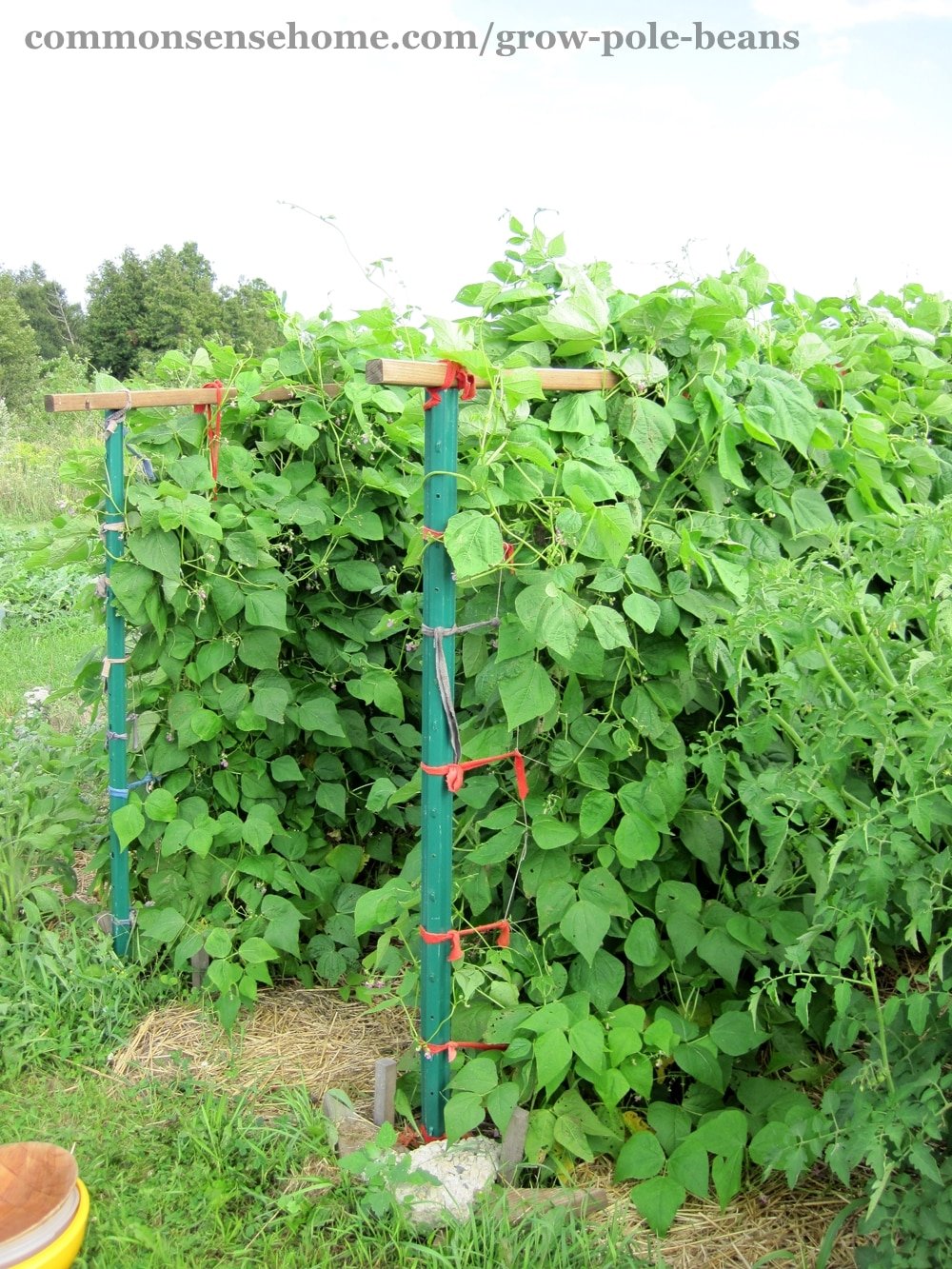Pole beans are one of our favorite vegetables. We share how to grow pole beans, our easy trellis system, favorite varieties, companion plants, and fertilizing tips.
We grow pole beans for fresh eating and preserving, plus extra to swap with the neighbors. Once the season gets rolling, our vines produce until frost. We also save some beans for seed each year.
Growing green beans is a fun and rewarding way to add fresh produce to your diet. But without proper support, bean plants can easily fall over and produce poorly. That’s where a sturdy trellis comes in!
In this article, I’ll walk you through how to build a custom green bean trellis from start to finish using basic materials. With just a few tools and supplies, you can create the ideal trellis structure to support healthy, vertical green bean growth in your garden.
Benefits of Using a Trellis for Green Beans
Here are some of the key advantages of providing a trellis for your green bean plants:
-
Promotes upright growth and improves airflow and sun exposure
-
Allows you to grow more beans in a smaller footprint by training vines upward
-
Keeps beans off the ground, reducing rot and pest issues
-
Makes beans easier to spot and harvest
-
Can be reused year after year with proper storage
Planning Your Green Bean Trellis
There are many possible trellis designs, but a classic A-frame or tepee shape works great for green beans. When planning your trellis consider
-
The size of your garden bed – Trellis should span the length of your planting row
-
How many bean plants you want to support – Allow 12-18 inches between each seed planting
-
The height of your trellis – Climbing beans can grow 6 feet or more!
-
Materials you have available – Poles, fencing, twine, hardware cloth, etc.
For a small raised bed, an A-frame trellis 4 feet wide by 6 feet tall is ideal. Make it longer or taller to suit larger spaces.
Recommended Materials for Constructing a Bean Trellis
You likely have many of these supplies already or can easily acquire them:
-
2-4 wooden garden stakes or posts – 2-3 inches diameter, at least 6 feet long
-
Roll of 12-16 gauge wire fencing or hardware cloth – At least 4 feet wide
-
Staples or zip ties for fastening fencing to posts
-
Twine, cord, or additional wire for making a bean trellis grid
-
Trowel or shovel for digging holes for posts
-
Hammer for pounding stakes into the ground
-
Wire cutters
-
Work gloves for safety
Choose rot-resistant wood like cedar for longevity. Galvanized hardware cloth resists rust over time.
Step-By-Step Instructions for Building a Green Bean Trellis
Follow these simple steps to construct your own bean trellis:
Step 1: Install the End Posts
Use a trowel or shovel to dig 6-8 inch deep holes where you want your trellis ends positioned. Pound garden stakes firmly into the holes and refill dirt around posts.
Step 2: Attach Crossbar
Cut a long garden stake to the desired trellis width. Secure it horizontally across the top of the end posts using staples, nails, or zip ties.
Step 3: Fasten Wire Fencing
Cut hardware cloth or wire fencing to the length and height of your trellis. Attach securely to the front of the posts and crossbar using staples or ties.
Step 4: Add Trellis Grid (Optional)
For extra support, cut lengths of twine and crisscross between posts. Or run additional wires horizontally across the fencing every 6-12 inches.
Step 5: Secure Lower Edge
Bury bottom fencing edge a few inches underground or weigh down with rocks to keep the trellis anchored.
Once built, your DIY bean trellis is ready for planting! It’s that easy to create a lasting structure that will support years of bountiful green bean harvests.
Tips for Getting the Most out of Your Bean Trellis
Follow these best practices to grow thriving green beans on your trellis:
-
Plant pole or bush bean varieties with strong vines that wrap well
-
Space seeds 4-6 inches apart for optimal growth density
-
Fertilize regularly and provide consistent moisture for healthy plants
-
Guide vines onto trellis and loosely tie stems initially before they grab on
-
Monitor for pests like aphids and diseases like rust or anthracnose
-
Pick beans regularly once they size up to maintain productivity
-
Remove vines at end of season or trim back for a potential second harvest
With a well-built bean trellis and proper care, you can harvest pounds of crisp, delicious green beans all season long!
Customizing Your Bean Trellis Design
While a basic A-frame or tepee trellis works great, you can also customize your design in lots of creative ways:
-
Make a taller arched trellis using flexible bamboo poles
-
Top with an old basket, pot, or wheelbarrow for decoration
-
Add side panels of fencing to create an enclosed growing cage
-
Make a tunnel trellis by bending and anchoring poles over a pathway
-
Use salvaged materials like ribbons, twine, or scrap wood for accents
-
Paint or decorate your trellis to match your garden style
Let your imagination run wild! The possibilities are endless for personalizing your bean trellis.
Helpful Tips for Sturdy, Long-Lasting Trellises
Follow these tips and tricks to ensure your handmade bean trellis stands the test of time:
-
Use pressure-treated lumber or naturally rot-resistant wood
-
Set posts at least 12-18 inches deep into the ground for stability
-
Reinforce joints with brackets, screws, or nails for added strength
-
Check trellis integrity each season and replace any broken components
-
Disassemble and store trellis out of weather if possible when not in use
-
Consider spraying wood with sealant to help repel moisture and insects
Take time to build your trellis robustly from the start and it can serve your garden for 5+ years!
Troubleshooting Common Bean Trellis Problems
If issues crop up with your bean trellis, here are some quick fixes:
Sagging support wires: Tighten wires or replace with stronger gauge.
Leaning posts: Re-anchor posts deeper or attach braces for support.
Rusting hardware cloth: Sand any rust spots and spray with protecive coating.
Rotting wood: Replace any deteriorated wood right away to prevent collapsing.
Pests on trellis: Spray trellis with insecticidal soap and prune away infested vines.
Plants overgrowing trellis: Trim back vines and consider a taller trellis for next season.
With attentive maintenance, your DIY bean trellis can offer years of reliable service.
Fun Ideas for Decorating Your Green Bean Trellis
A bare wood trellis works just fine, but you can also decorate it for added beauty:
-
Paint it a bright, cheerful color like yellow, blue, or red
-
Stencil on a fun pattern or favorite quote with outdoor paint
-
Wrap twinkle lights along the outside for a magical nighttime look
-
Drape the crossbar with flowering vine cuttings or string lights
-
Add your own artwork like garden signs or wind chimes
-
Affix decorative elements like birdhouses, sun catchers, or mobiles
Let your creativity run wild to make your trellis as unique as your garden!
FAQ’s About Constructing and Using a Bean Trellis
What is the ideal height for a green bean trellis?
For most pole bean varieties, a 6 to 8 foot trellis will provide adequate support. Some very vigorous vines may reach up to 10 feet.
Should I use pressure-treated lumber for garden trellises?
Pressure-treated lumber contains preservatives and is not recommended for edible gardens. Opt for naturally rot-resistant woods or untreated lumber placed where it won’t contact foliage.
How much space do I need to leave between green bean plants on a trellis?
Spacing the plants 4 to 6 inches apart on each side of your trellis allows ample room for growth and airflow. Plant seeds 12-18 inches apart.
Is it better to plant pole or bush beans for a trellis?
Pole beans are bred to climb and typically have longer vines better suited for trellising. However, some bush beans can also be lightly trellised.
Can I train multiple rows of green beans onto one large trellis?
Yes, you can train beans onto both sides of a freestanding trellis. Space the rows about 2 feet apart for easiest access.

k
What’s the Best Pole Bean Trellis?
I’ve seen a lot of creative and beautiful trellises made for pole beans or out of things that people had on hand. Some bean trellis options include:
- Nylon trellis netting – our favorite
- Pole beans can be used to make a nice seasonal privacy screen out of wire fencing.
- Pallets and cattle panels—These are being used as tomato trellises, but they can also be used for beans.
- To support a bean, line up sticks or bamboo poles in a row or make a tepee out of them.
- String trellis: String trellises are usually tied together at the top and bottom to make a tepee shape. Beans may require some encouragement to climb the strings. And if you use biodegradable string, you can throw them away with your bean stalks when the season is over.
- In an arbor, you don’t have to grow just flowers or grapes. You can also grow bean blossoms, which are pretty and tasty.
- The folding metal trellis VineSpineTM—these metal grids can be stored flat.
Whatever bean trellis you choose, make sure it is well-secured so it doesn’t tip over in strong winds. The neighbor’s lost their bean tepee in a storm, just when the beans were starting to mature. It was a big mess, and the beans never fully recovered.
We use nylon trellis netting supported with metal fence posts and wooden cross pieces on top.
- Wide openings are easy to reach through for harvesting. You don’t have to try to reach inside a pyramid trellis to pick fruit; you can do it from both sides.
- Strong: My trellis has been around for many years, except for the time I accidentally cut it with clippers. You might see some of the patches in the photos. Most of my netting is over 5 years old.
- They store in a small amount of space. The nets can be put in a small bag, and the support posts can be stacked in a greenhouse corner.
Place 6- 7 foot tall metal fence posts at five foot intervals along the row. Secure trellis netting to each post in at least four spots. I use strips of old sweatpants for this. You could use twine or whatever you have on hand.
To make weeding easy, we place wet newspaper between the double rows and cover it with mulch. Then we hang the trellis above the mulch. Make sure to get the trellis up while the beans are still small so they don’t get tangled.


I put beans on both sides of the trellis, so as the season goes on, it gets pretty heavy. An old wooden cross is tied to the top of the fence posts to help the bean plants stand up. I use 2″x2″ or 1″x2″ pieces around 6 feet long. We tether the trellis netting to it at regular intervals.
The beans should shoot right up the trellis without much fuss. Once in a while you may need to guide them in the right direction.

How to Grow Pole Beans
- Grow pole beans in a garden bed or container. Full sun is best, but plants will tolerate light shade. Best soil pH is 6. 5 -7. 5 (neutral soil).
- Plant outside, once the soil temperature reaches 60°F (16ºC). Beans do not do well when moved from one spot to another. They can be sprouted inside to get a head start.
- Plant pole bean seeds 1 inch deep (2.5 cm)
- Set the plants far apart. For pyramids or poles, use four plants per hill or pole, with hills about 18 inches apart. For trellises, place seeds 3″ (7. 5 cm) apart.
- Leave 3 to 4 feet between rows so you can pick. Do not be fooled by how small the seeds are; if you take good care of them, these plants will grow very big. We plant in two rows, one on each side of the trellis.
- Pole bean seeds should germinate in 7-10 days
- Watering Needs: Plant in well drained soil. Soil should be damp (but never soggy) at planting. For the plants to grow, they need about an inch of water every week. If the plants get too dry, they’ll stop making beans.
- Harvest pole beans every 2-3 days.
In the video below, my son is planting our 2014 crop of pole beans.
